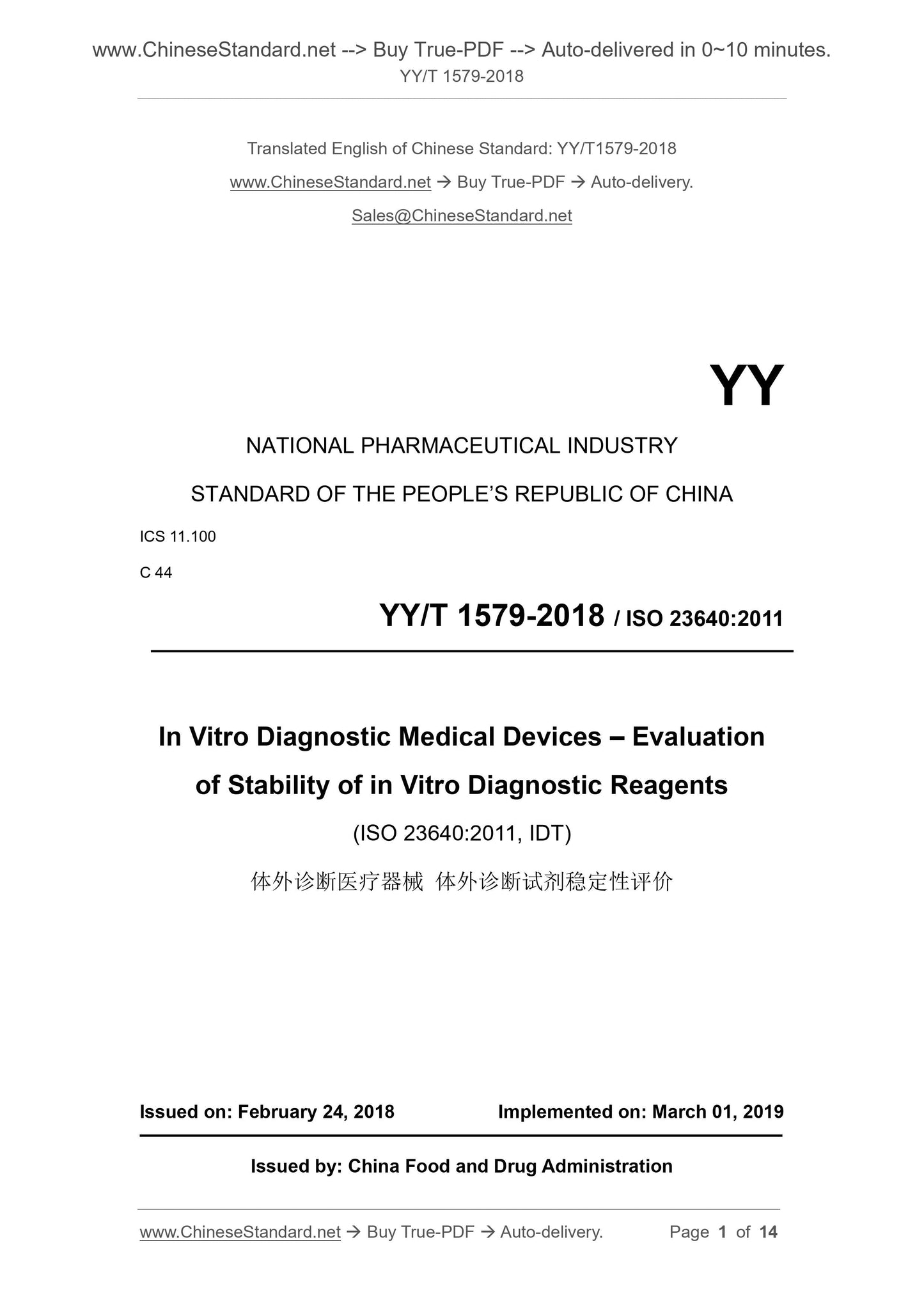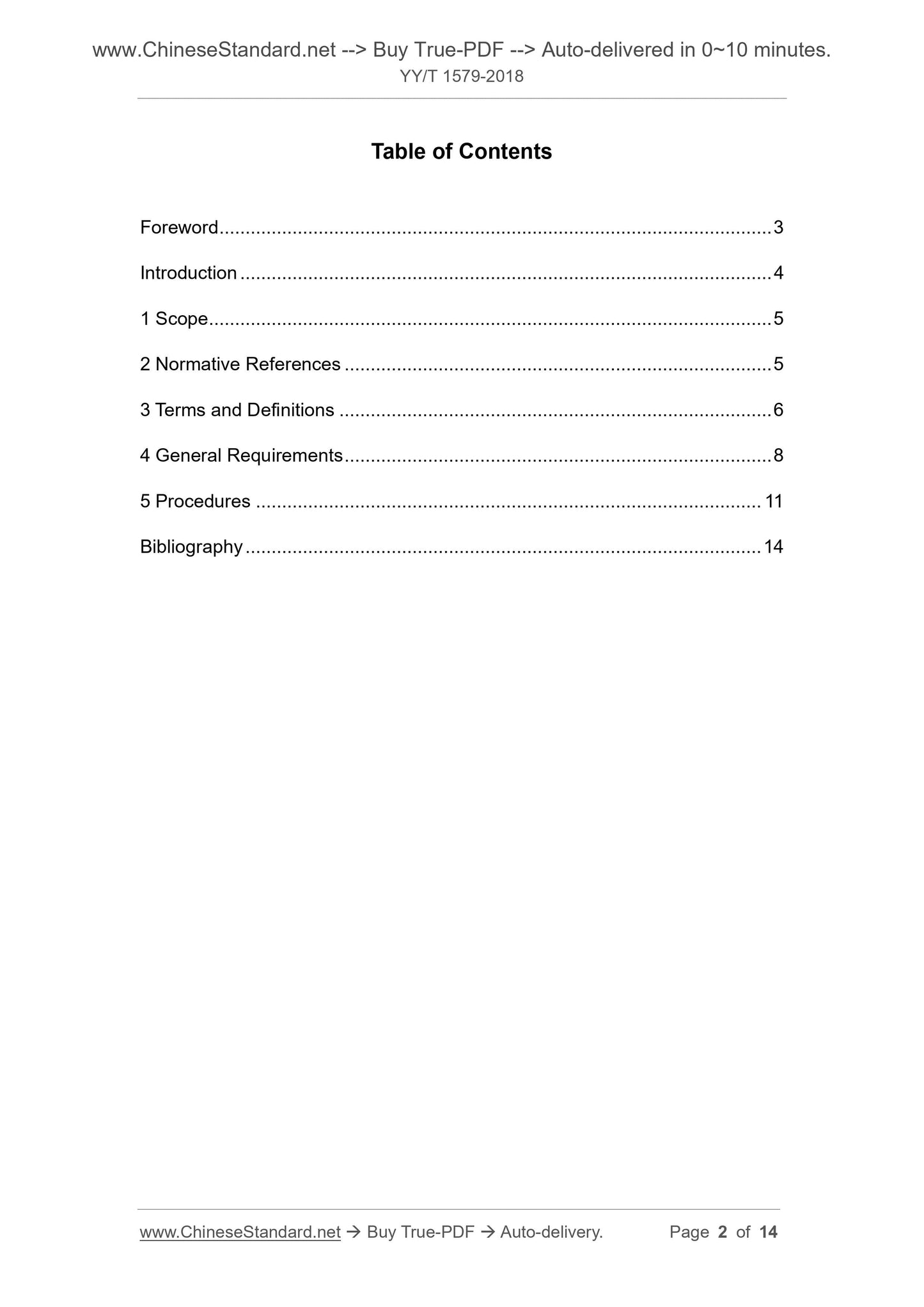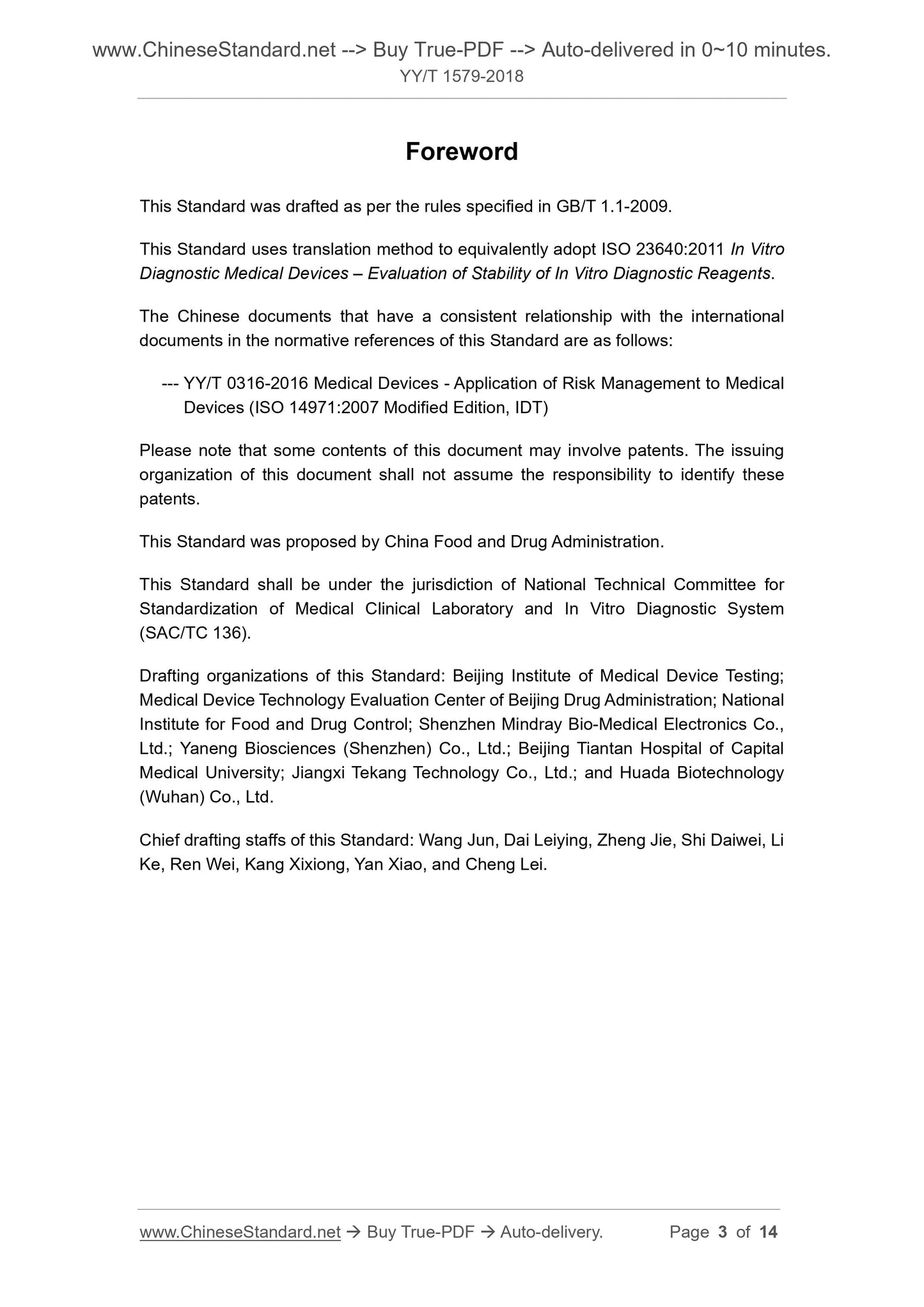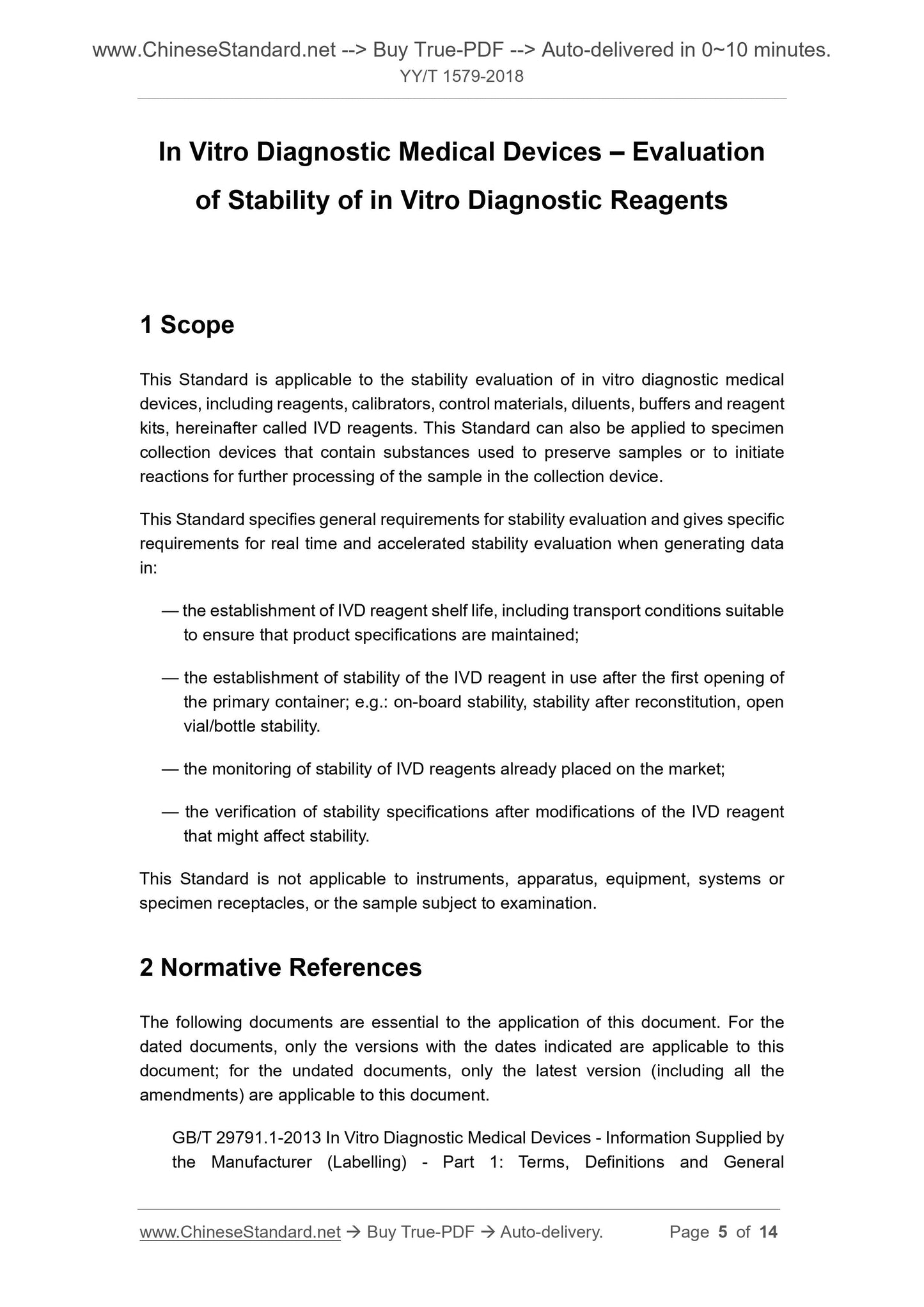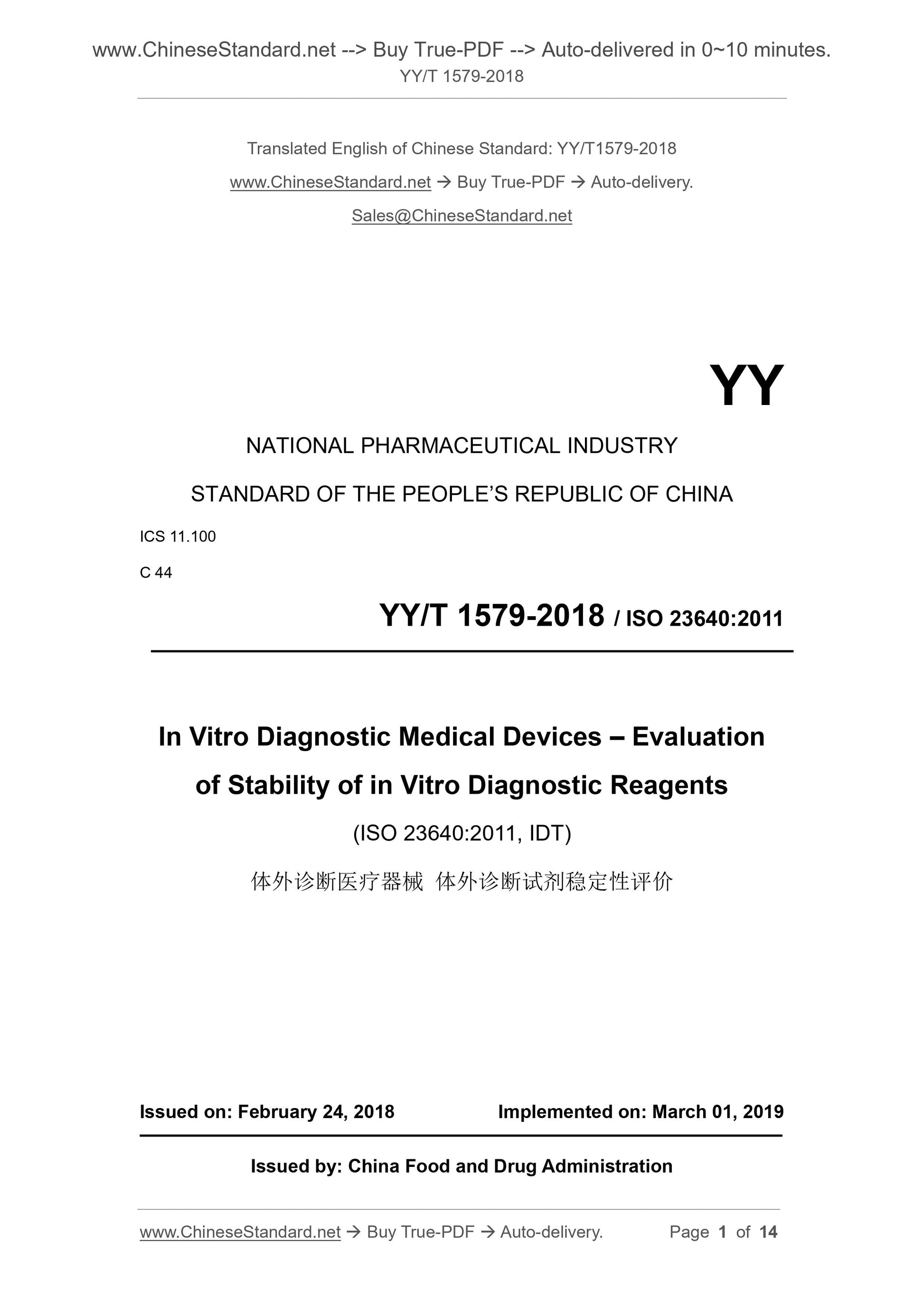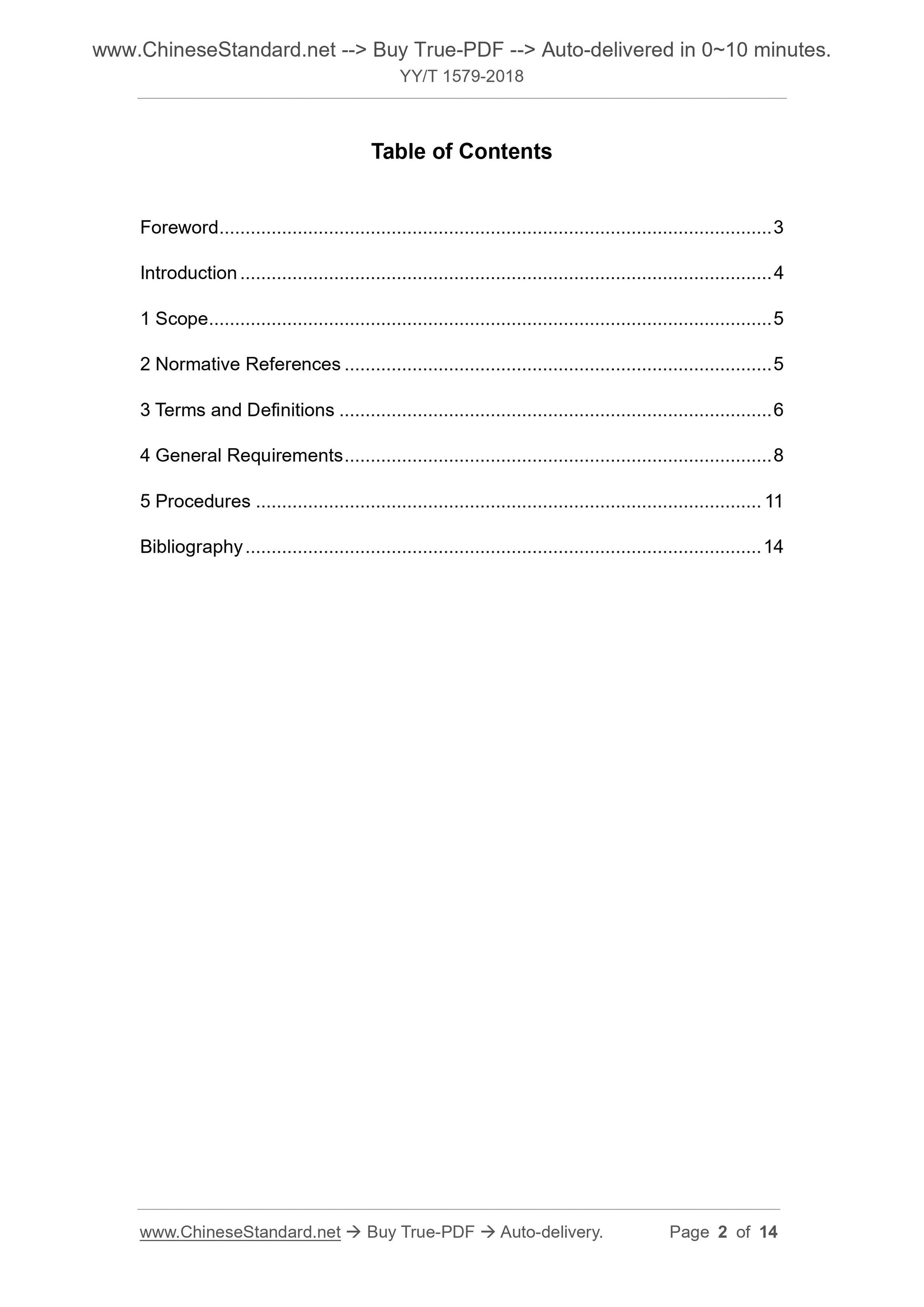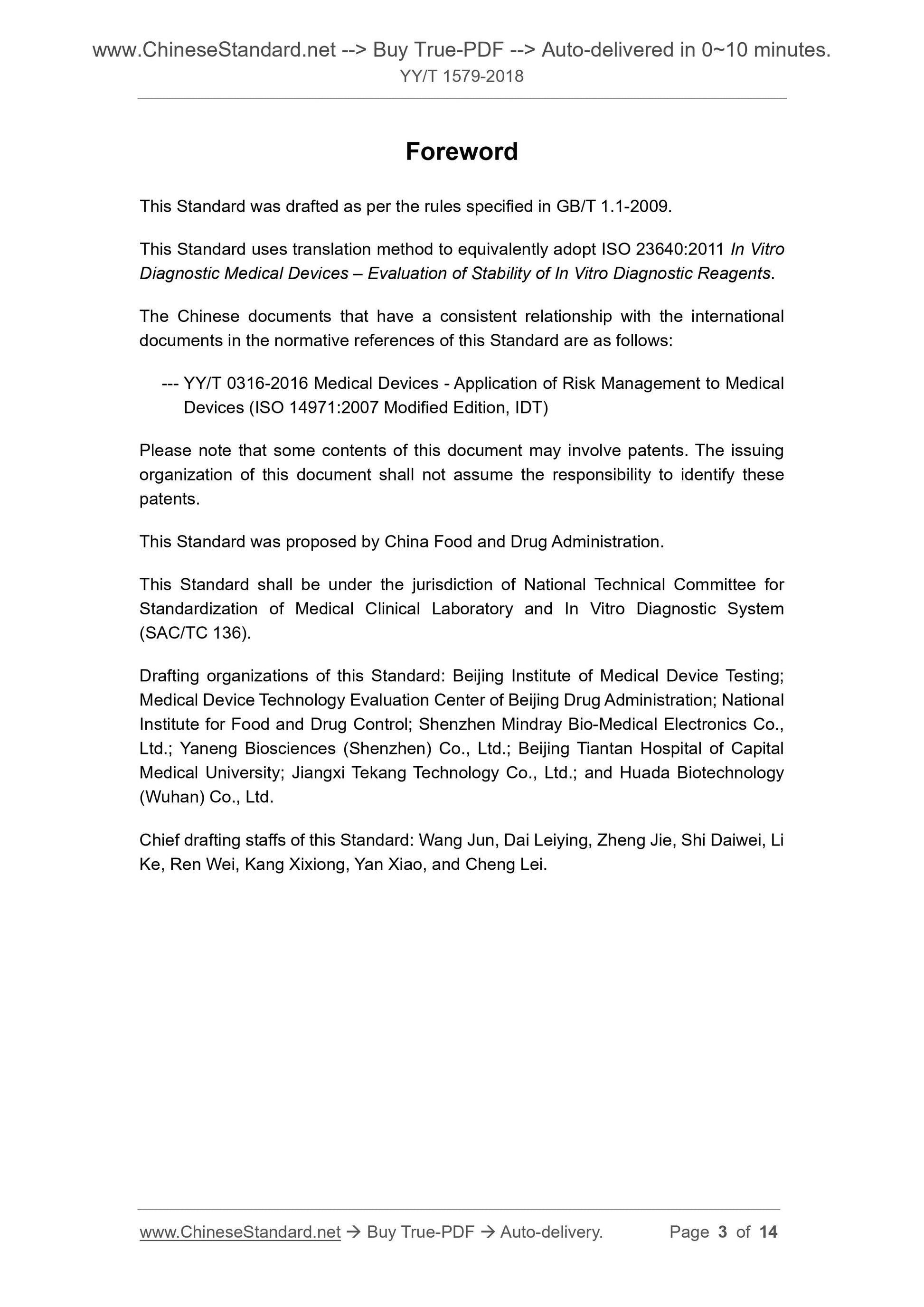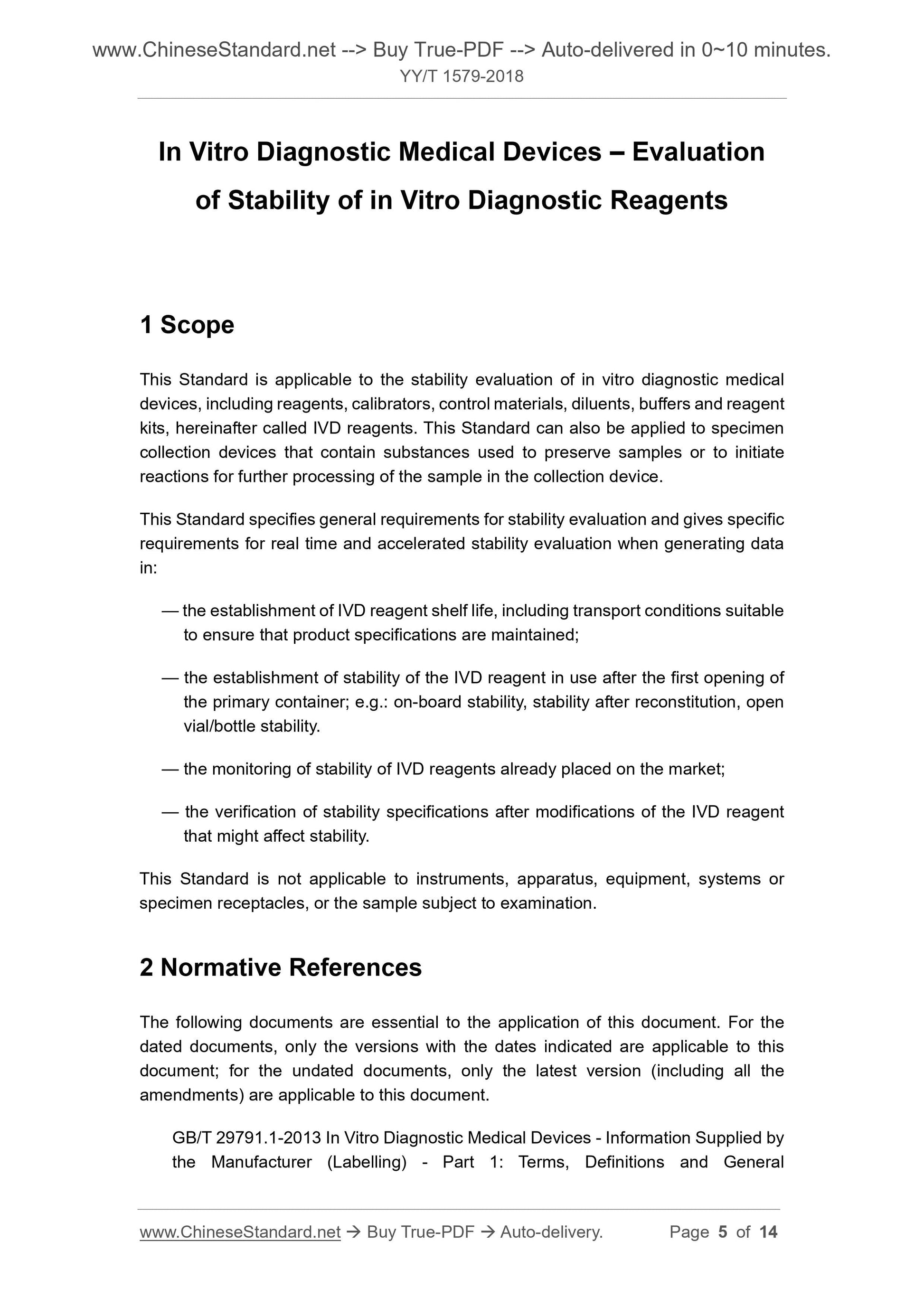1
/
の
4
PayPal, credit cards. Download editable-PDF and invoice in 1 second!
YY/T 1579-2018 English PDF (YYT1579-2018)
YY/T 1579-2018 English PDF (YYT1579-2018)
通常価格
$150.00 USD
通常価格
セール価格
$150.00 USD
単価
/
あたり
配送料はチェックアウト時に計算されます。
受取状況を読み込めませんでした
Delivery: 3 seconds. Download true-PDF + Invoice.
Get QUOTATION in 1-minute: Click YY/T 1579-2018
Historical versions: YY/T 1579-2018
Preview True-PDF (Reload/Scroll if blank)
YY/T 1579-2018: In vitro diagnostic medical devices--Evaluation of stability of in vitro diagnostic reagents
YY/T 1579-2018
In vitro diagnostic medical devices--Evaluation of stability of in vitro diagnostic reagents
ICS 11.100
C44
People's Republic of China Pharmaceutical Industry Standard
In vitro diagnostic medical device
In vitro diagnostic reagent stability evaluation
(ISO 23640.2011, IDT)
Published on.2018-02-24
2019-03-01 implementation
State Food and Drug Administration issued
Foreword
This standard was drafted in accordance with the rules given in GB/T 1.1-2009.
This standard uses the translation method equivalent to ISO 23640.2011 "in vitro diagnostic medical device in vitro diagnostic reagent stability evaluation".
The documents of our country that have a consistent correspondence with the international documents referenced in this standard are as follows.
---YY/T 0316-2016 Medical device risk management for medical devices (ISO 14971.2007 more genuine, IDT)
Please note that some of the contents of this document may involve patents. The issuing organization of this document is not responsible for identifying these patents.
This standard was proposed by the State Food and Drug Administration.
This standard is under the jurisdiction of the National Medical Clinical Laboratory and the In vitro Diagnostic System Standardization Technical Committee (SAC/TC136).
This standard was drafted. Beijing Medical Device Inspection Institute, Beijing Medical Supervision Bureau Medical Device Technology Evaluation Center, Chinese food
Drug Testing Institute, Shenzhen Mindray Biomedical Electronics Co., Ltd., Asia Energy Biotechnology (Shenzhen) Co., Ltd., Capital Medical University
Beijing Tiantan Hospital, Jiangxi Tekang Technology Co., Ltd., Huada Biotechnology (Wuhan) Co., Ltd.
The main drafters of this standard. Wang Jun, Dai Leiying, Zheng Yi, Shi Dawei, Li Ke, Ren Wei, Kang Xixiong, Yan Wei, Cheng Lei.
introduction
An important aspect of the development and manufacture of in vitro diagnostic reagents is the initial design of the product's stability, and then determine and verify the delivery
The expiration date of the products in the market. The manufacturer evaluates to determine shelf life, transport stability, and stability of use. In order to be heavy
To provide information to the user, the manufacturer identifies key factors that may affect the stability of the in vitro diagnostic reagent and carefully evaluates these characteristics. body
The stability of the external diagnostic reagent affects the performance of the device and thus affects the patient's diagnosis.
It is the responsibility of the manufacturer to determine and monitor the stability of the in vitro diagnostic reagent to ensure that the performance characteristics of the product are maintained. In stability
Before the information is provided to the user, it is best to complete the establishment of a stability evaluation program, generate valid data, and analyze to establish an appropriate shelf life and transportation limit.
System and usage stability information.
In vitro diagnostic medical device
In vitro diagnostic reagent stability evaluation
1 Scope
This standard applies to in vitro diagnostic medical devices (including reagents, calibrators, controls, diluents, buffers, and kits, hereinafter referred to as
Stability evaluation of "in vitro diagnostic reagents"). This standard also applies to substances containing sample storage or to initiate reactions to further process samples.
A sample collection device for the substance.
This standard specifies the general requirements for stability evaluation when generating data from the following processes, as well as for real-time stability and acceleration stability.
Specific requirements for sex.
--- Establish the shelf life of in vitro diagnostic reagents, including the determination of the transport conditions to ensure product performance;
--- Establish the stability of the use of in vitro diagnostic reagents after initial opening of the initial packaging, for example, in machine stability, reconstitution stability, opening
stability;
---Monitor the stability of in vitro diagnostic reagents that have been placed on the market;
--- Verification of the stability of the improved reagent. After the reagent is improved, it may affect the stability and the stability needs to be verified.
This standard does not apply to instruments, devices, equipment, systems, specimen containers, and test samples.
2 Normative references
The following documents are indispensable for the application of this document. For dated references, only dated versions apply to this article.
Pieces. For undated references, the latest edition (including all amendments) applies to this document.
GB/T 29791.1-2013 Information provided by in vitro diagnostic medical device manufacturers (labeling) Part 1. Terms, definitions and
General requirements (ISO 18113-1.2009, IDT)
ISO 14971 Medical Device Risk Management for Medical Devices (Medicaldevices-Applicationofriskman-
Agementtomedicaldevices)
3 Terms and definitions
The following terms and definitions apply to this document.
3.1
Accelerated stability evaluation acceleratedstabilityevaluation
Predict the shelf life of in vitro diagnostic reagents by designing severe environmental conditions to increase the rate of chemical and/or physical degradation and change
the study.
Note. The design of the accelerated stability evaluation may include extreme conditions of temperature, humidity, light or vibration.
3.2
Arrheniusplot
A mathematical function that describes the approximate relationship between the chemical reaction rate constant and temperature and activation energy.
[CLSIEP25-A]
3.3
Batch batch;lot
A specified amount of material having consistent characteristics produced by a process or series of processes.
[GB/T 29791.1-2013, definition 3.5]
3.4
Batch number batchcode; lotnumber
A specific number and/or combination of letters that can clearly identify a batch and make it traceable to manufacturing, packaging, labeling, and shipping history.
[GB/T 29791.1-2013, definition 3.6]
3.5
Expiration date expirydate;expirationdate
The upper limit of the time interval under which the material properties can be guaranteed by storage under specified conditions.
Note. The manufacturer sets the expiration date of in vitro diagnostic reagents, calibrants, controls, and other components based on the stability characteristics determined by the assay.
[GB/T 29791.1-2013, definition 3.17]
3.6
In vitro diagnostic medical device invitrodiagnosticmedicaldevice
IVD medical device IVDmedicaldevice
Used alone or in combination, the manufacturer is expected to use the device for in vitro testing of human specimens, and the test is pure or mainly to provide diagnosis and monitoring.
For the purpose of compatibility information, the device includes reagents, calibrators, controls, sample containers, software, and related instruments or devices or other items.
[GB/T 29791.1-2013, definition 3.27]
3.7
In vitro diagnostic reagent invitrodiagnosticreagent
IVD Reagent IVDreagent
It is intended by the manufacturer to be used as a chemical, biological or immunological component, solution or preparation for in vitro diagnostic medical devices.
[GB/T 29791.1-2013, definition 3.28]
3.8
Real-time stability evaluation realtimestabilityevaluation
The in vitro diagnostic reagent is placed under the conditions specified by the manufacturer to establish or verify the reagent shelf life test.
Note. Conditions affecting the stability of in vitro diagnostic reagents may include temperature, transport conditions, vibration, ...
Get QUOTATION in 1-minute: Click YY/T 1579-2018
Historical versions: YY/T 1579-2018
Preview True-PDF (Reload/Scroll if blank)
YY/T 1579-2018: In vitro diagnostic medical devices--Evaluation of stability of in vitro diagnostic reagents
YY/T 1579-2018
In vitro diagnostic medical devices--Evaluation of stability of in vitro diagnostic reagents
ICS 11.100
C44
People's Republic of China Pharmaceutical Industry Standard
In vitro diagnostic medical device
In vitro diagnostic reagent stability evaluation
(ISO 23640.2011, IDT)
Published on.2018-02-24
2019-03-01 implementation
State Food and Drug Administration issued
Foreword
This standard was drafted in accordance with the rules given in GB/T 1.1-2009.
This standard uses the translation method equivalent to ISO 23640.2011 "in vitro diagnostic medical device in vitro diagnostic reagent stability evaluation".
The documents of our country that have a consistent correspondence with the international documents referenced in this standard are as follows.
---YY/T 0316-2016 Medical device risk management for medical devices (ISO 14971.2007 more genuine, IDT)
Please note that some of the contents of this document may involve patents. The issuing organization of this document is not responsible for identifying these patents.
This standard was proposed by the State Food and Drug Administration.
This standard is under the jurisdiction of the National Medical Clinical Laboratory and the In vitro Diagnostic System Standardization Technical Committee (SAC/TC136).
This standard was drafted. Beijing Medical Device Inspection Institute, Beijing Medical Supervision Bureau Medical Device Technology Evaluation Center, Chinese food
Drug Testing Institute, Shenzhen Mindray Biomedical Electronics Co., Ltd., Asia Energy Biotechnology (Shenzhen) Co., Ltd., Capital Medical University
Beijing Tiantan Hospital, Jiangxi Tekang Technology Co., Ltd., Huada Biotechnology (Wuhan) Co., Ltd.
The main drafters of this standard. Wang Jun, Dai Leiying, Zheng Yi, Shi Dawei, Li Ke, Ren Wei, Kang Xixiong, Yan Wei, Cheng Lei.
introduction
An important aspect of the development and manufacture of in vitro diagnostic reagents is the initial design of the product's stability, and then determine and verify the delivery
The expiration date of the products in the market. The manufacturer evaluates to determine shelf life, transport stability, and stability of use. In order to be heavy
To provide information to the user, the manufacturer identifies key factors that may affect the stability of the in vitro diagnostic reagent and carefully evaluates these characteristics. body
The stability of the external diagnostic reagent affects the performance of the device and thus affects the patient's diagnosis.
It is the responsibility of the manufacturer to determine and monitor the stability of the in vitro diagnostic reagent to ensure that the performance characteristics of the product are maintained. In stability
Before the information is provided to the user, it is best to complete the establishment of a stability evaluation program, generate valid data, and analyze to establish an appropriate shelf life and transportation limit.
System and usage stability information.
In vitro diagnostic medical device
In vitro diagnostic reagent stability evaluation
1 Scope
This standard applies to in vitro diagnostic medical devices (including reagents, calibrators, controls, diluents, buffers, and kits, hereinafter referred to as
Stability evaluation of "in vitro diagnostic reagents"). This standard also applies to substances containing sample storage or to initiate reactions to further process samples.
A sample collection device for the substance.
This standard specifies the general requirements for stability evaluation when generating data from the following processes, as well as for real-time stability and acceleration stability.
Specific requirements for sex.
--- Establish the shelf life of in vitro diagnostic reagents, including the determination of the transport conditions to ensure product performance;
--- Establish the stability of the use of in vitro diagnostic reagents after initial opening of the initial packaging, for example, in machine stability, reconstitution stability, opening
stability;
---Monitor the stability of in vitro diagnostic reagents that have been placed on the market;
--- Verification of the stability of the improved reagent. After the reagent is improved, it may affect the stability and the stability needs to be verified.
This standard does not apply to instruments, devices, equipment, systems, specimen containers, and test samples.
2 Normative references
The following documents are indispensable for the application of this document. For dated references, only dated versions apply to this article.
Pieces. For undated references, the latest edition (including all amendments) applies to this document.
GB/T 29791.1-2013 Information provided by in vitro diagnostic medical device manufacturers (labeling) Part 1. Terms, definitions and
General requirements (ISO 18113-1.2009, IDT)
ISO 14971 Medical Device Risk Management for Medical Devices (Medicaldevices-Applicationofriskman-
Agementtomedicaldevices)
3 Terms and definitions
The following terms and definitions apply to this document.
3.1
Accelerated stability evaluation acceleratedstabilityevaluation
Predict the shelf life of in vitro diagnostic reagents by designing severe environmental conditions to increase the rate of chemical and/or physical degradation and change
the study.
Note. The design of the accelerated stability evaluation may include extreme conditions of temperature, humidity, light or vibration.
3.2
Arrheniusplot
A mathematical function that describes the approximate relationship between the chemical reaction rate constant and temperature and activation energy.
[CLSIEP25-A]
3.3
Batch batch;lot
A specified amount of material having consistent characteristics produced by a process or series of processes.
[GB/T 29791.1-2013, definition 3.5]
3.4
Batch number batchcode; lotnumber
A specific number and/or combination of letters that can clearly identify a batch and make it traceable to manufacturing, packaging, labeling, and shipping history.
[GB/T 29791.1-2013, definition 3.6]
3.5
Expiration date expirydate;expirationdate
The upper limit of the time interval under which the material properties can be guaranteed by storage under specified conditions.
Note. The manufacturer sets the expiration date of in vitro diagnostic reagents, calibrants, controls, and other components based on the stability characteristics determined by the assay.
[GB/T 29791.1-2013, definition 3.17]
3.6
In vitro diagnostic medical device invitrodiagnosticmedicaldevice
IVD medical device IVDmedicaldevice
Used alone or in combination, the manufacturer is expected to use the device for in vitro testing of human specimens, and the test is pure or mainly to provide diagnosis and monitoring.
For the purpose of compatibility information, the device includes reagents, calibrators, controls, sample containers, software, and related instruments or devices or other items.
[GB/T 29791.1-2013, definition 3.27]
3.7
In vitro diagnostic reagent invitrodiagnosticreagent
IVD Reagent IVDreagent
It is intended by the manufacturer to be used as a chemical, biological or immunological component, solution or preparation for in vitro diagnostic medical devices.
[GB/T 29791.1-2013, definition 3.28]
3.8
Real-time stability evaluation realtimestabilityevaluation
The in vitro diagnostic reagent is placed under the conditions specified by the manufacturer to establish or verify the reagent shelf life test.
Note. Conditions affecting the stability of in vitro diagnostic reagents may include temperature, transport conditions, vibration, ...
Share
